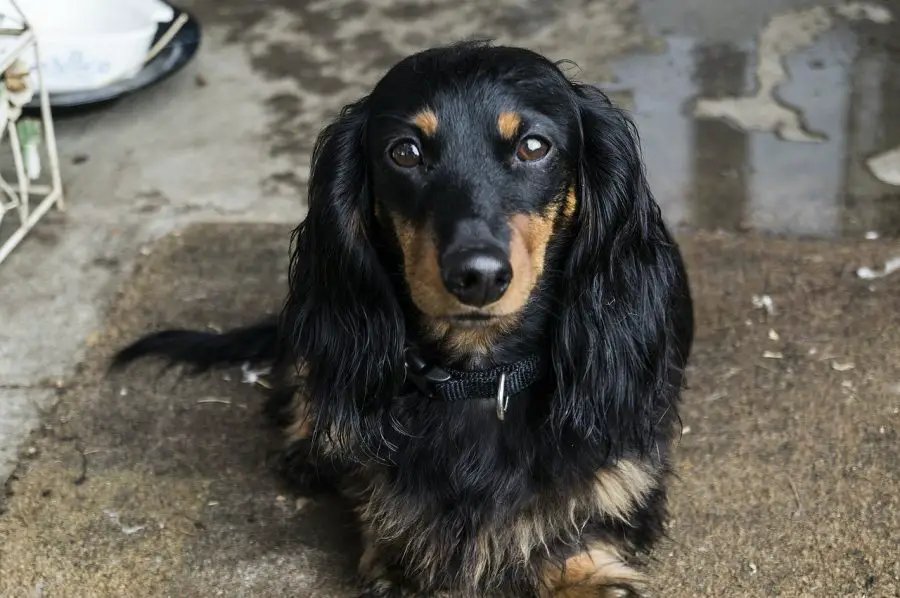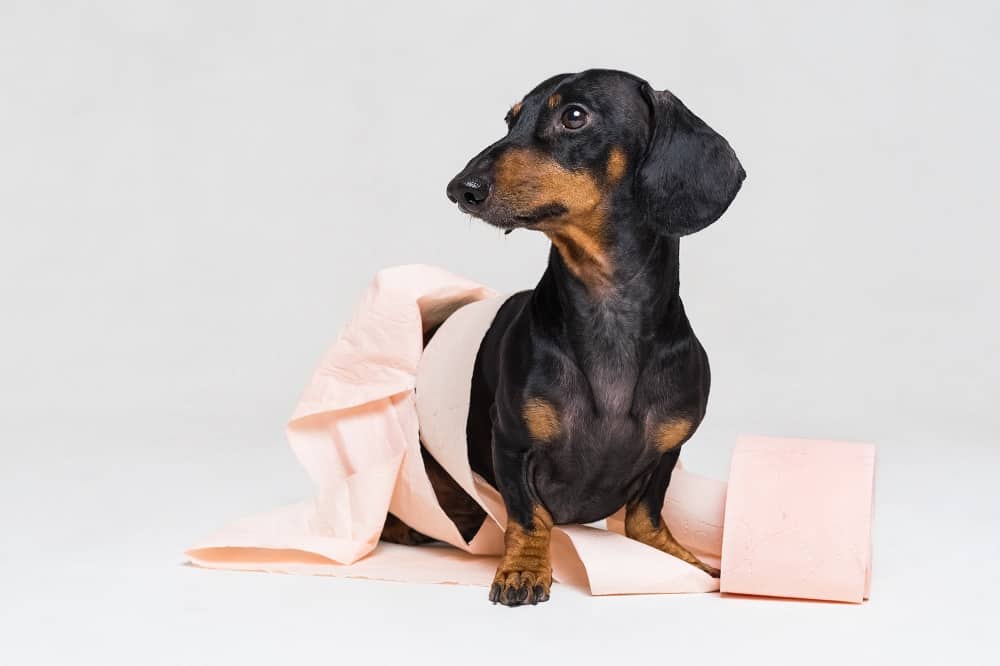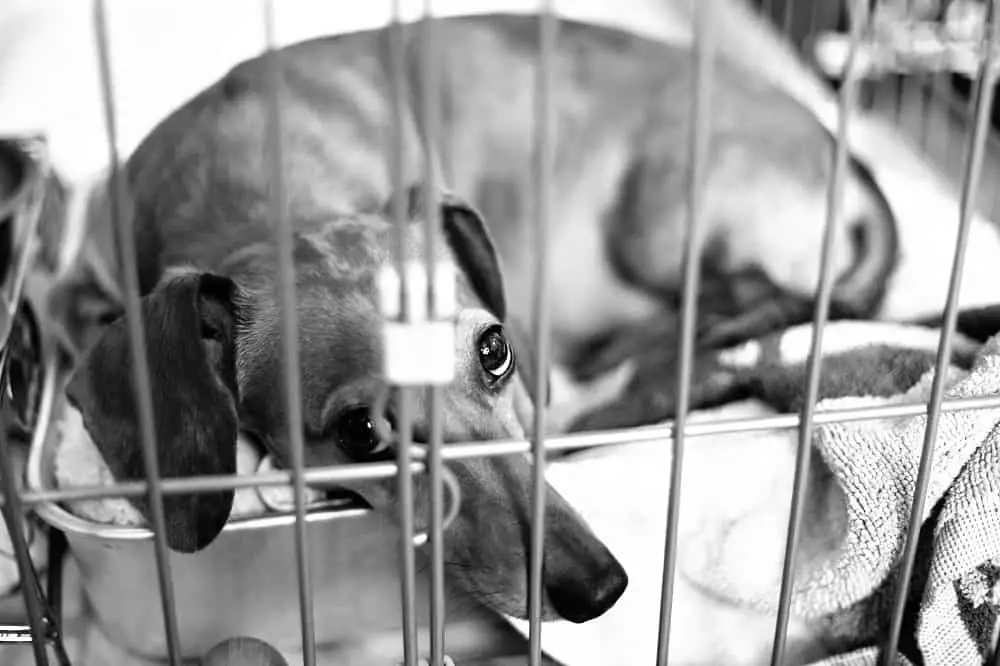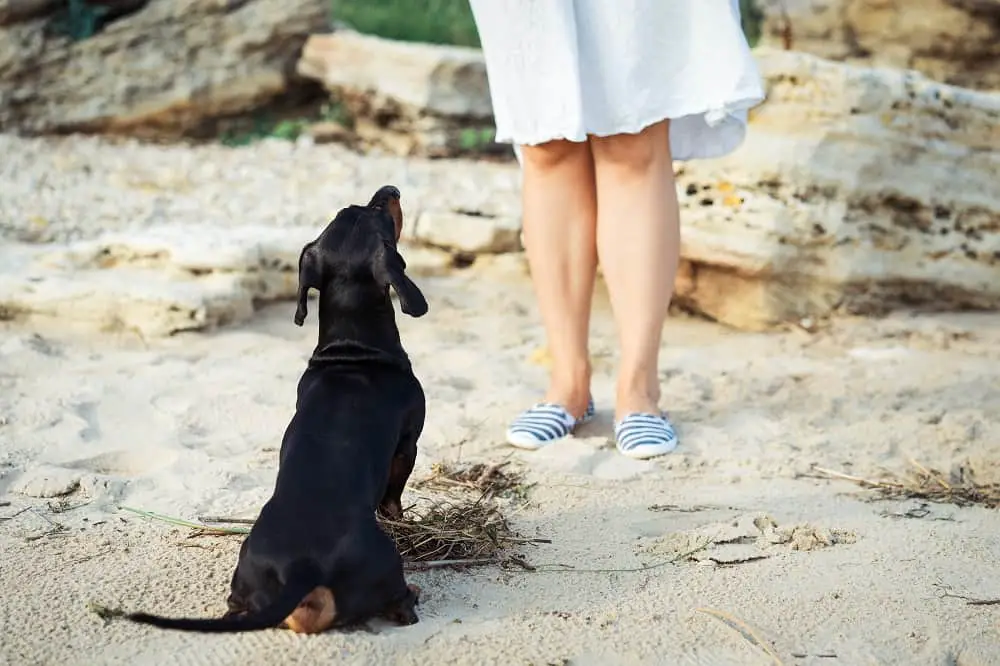While we dachshund lovers adore everything about our beloved short-legged, long-bodied canine friends, there is one thing we aren’t too fond of – the fact that dachshunds are notoriously known to be difficult to house train.
With their stubborn nature and independent minds, they are usually one of the hardest breeds of dogs to house train.

However, there are many tactics and tips and tricks to try to make sure your dachshund goes to the toilet outside.
Obviously is it much better to train your dachshund as a puppy, but if you don’t get your dog as a puppy, you need to start as soon as the dog comes into your care.
Signs your dachshund needs to go the toilet
Most dogs will try and let you know they need to go to the toilet.
However, when starting out the process of house training, you will need to be more observant and watch for the signs yourself.
Usually when the pup lowers their head and starts sniffing around, it means they are about to relieve themselves.
If your dog is with you in a room and suddenly leaves, chances are they have left to go and look for a place to go to the toilet.
If they pace around in a circle, they could also be looking for a spot.
What are the different methods to house break your dachshund?
There are two main techniques you can use to help your dachshund go to the toilet in the right place – the direct method and the paper method.
The direct method is better for dogs who have a fenced yard and the paper method is better for dogs who live mostly inside and don’t have direct access to the outdoors.
It is important to keep at it for at least the first 3 weeks so that these habits are formed in the puppy’s mind.
With both methods, you need to keep an eye out for the signs that a puppy needs to go to the toilet.
Direct method

Teach your dog to relieve himself outside with your praise.
Take your dachshund outside regularly, especially after he has eaten. If he relieves himself outside, don’t forget to praise him. If he doesn’t, take him outside every hour after that.
If you notice any of the signs he needs to go to the toilet while he is inside, take him outside immediately.
If he relieves himself inside, scold him and take him outside right away.
Use a newspaper to absorb his mess and take it outside and place it where you want him to use the toilet.
Once you are outside, don’t scold your dog, otherwise he may associate outside with you being angry. Never physically hit your dachshund as a form of punishment.
This form of house training will work quicker the less you allow your pup to go to the toilet inside.
If your dog does go inside, it is important to thoroughly clean it up as dogs can smell their markings afterwards and will associate that inside place as their toilet.
Paper method

This method is only ideal if the pup has nowhere outside to go to the toilet.
Choose a small, uncarpeted room in the house that you can use for a month where the pup can relieve himself.
Make sure you cover the whole floor with newspapers and after your dachshund eats, place him on the newspaper and stay there to keep an eye on him.
If he relieves himself, as with the direct method, praise him.
Make sure to save the paper he relieves himself on, replace all the other paper on the floor with fresh paper and place his soiled-on paper on the top.
He will be able to associate this smell with going to the toilet.
Over time your pup will learn that this is the spot and you can take away all the newspapers but one.
Always make sure you leave him with fresh papers whenever you go out.
Don’t let your dachshund ‘graze’
Grazing is when you let leave food out for your puppy to nibble on all day. When your pup is being toilet trained, their feeding and watering should be regulated.
It makes it easier for you to keep your eye on him after he has eaten and your dog then gets into a routine.
Every morning, give your pup fresh water and then after they have finished their meal, take the water away.
Take their food away after 20 minutes if your pup doesn’t eat it. Eventually, your pup will understand that they should eat and drink in one sitting.
Restrict your dachshund puppy’s space
In the beginning, when you are house training your pup, it is a good idea if you don’t let him run all over the house.
This ensures you don’t give him a chance to go to the toilet all over the house. Keep him in one room or in his crate if you are crate training.
Crate training your dachshund
No one ever said crate training a puppy was easy, especially a dachshund puppy, but it is the best way to house train your pup and keep them safe.
Crate training sessions should be a positive experience for your pup and never used a form of a punishment. Stay steady and consistent and keep persevering.

First, make sure you buy your dachshund puppy a big enough crate that he can move around in, but not too big, otherwise he may use it as his toilet.
Put a soft blanket in the crate, with a couple of chew toys and a hanging water bottle. Make it as comfortable as possible so that it is nice for him to go inside.
Secondly, an effective way to get him into the crate himself is by placing a treat in the middle of the crate and have a phrase you say every time, like ‘crate’ or ‘kennel’.
Once he is inside, gently close the door after him.
If he fusses (which he most likely will), stay close by but let him fuss until he settles down.
Once he does settle down, give him a treat inside his crate, praise him and then let him out. Take him outside so he can use the toilet.
This method works if you use it several times a day and make each time in the crate a little longer.
If you are also using the crate for your pup to sleep inside of at night, they will usually not soil themselves in it, as dogs don’t go to the toilet where they sleep.
Take your dachshund outside regularly
If you are using the direct method to toilet train your dachshund pup, make sure you take him outside regularly.
Because dachshund’s are small dogs, they have small bladders. This means they cannot store as much as a larger dog and therefore will need to go to the toilet more often.
It is cruel if you don’t let your pup relieve himself outside as it can also produce urinary tract and bladder infections. This is even more true for mini dachshunds.
Never punish your dachshund
Never rub your dog in their mess and never strike your dog. Not only is punishing your dachshund cruel, it also doesn’t work.
Doing those two things only makes your dog scared of you.
If bad behaviour is not corrected within a couple of seconds of your pup misbehaving, it is completely pointless to point it out, as your dog won’t understand what is has done wrong.
If your dog is misbehaving, a short, sharp scolding can let them know you aren’t happy – but that’s it. Never scream or yell loudly at your dog.
House training your adult dachshund
Perhaps your dachshund has come into your life at an older age. Or maybe they are house trained but only 95% of the time.
There is not a lot of difference between house training a puppy and an adult dog.
It is advisable you follow the same methods as when training a puppy.
Depending on the nature of the dog, you will either have to be really persistent as an older dog can be more set in their ways or you they will learn very quickly as they can be a lot wiser than a puppy.
Using verbal cues to help your dachshund relieve himself on command

It is important to pick some cue words and stick with them so that your dog starts to understand the meaning of the words.
In the beginning, when you are just starting the house training, use your cue words, for example: ‘go potty’ as your dog is finishing up their business, then when they have fully finished, say ‘yes’ with a smile and give them a treat.
They will learn that these words are associated with something positive.
After a week or so, use your cue words ‘go potty’ just before your dog is about to pee and say ‘yes’ once he’s finished.
Once he starts mastering it more, only give him treats when he pees very quickly or when he goes on command even if he doesn’t need to, but do continue to praise him every time.
You can also use verbal cues to teach your dachshund to do a number one or a number two – you just need to use different cue words for each command.
Tips if your dachshund is more stubborn than usual
As mentioned at the beginning of this article dachshunds can be hard work to house train as they are naturally a stubborn breed.
However, you may have struck lucky and ended up with an even more stubborn dachshund than usual! If this is the case, these tips can help you (and them) with the house training:
A doggy bell
A doggy bell or Potty Time Chime is just like a doorbell where your dog can activate it, making it very clear to you that he needs to go to toilet.
Help your puppy remember he needs to go to the toilet…
When a mother dog wants her babies to go to the toilet, she licks their bottoms. Use a warm, wet washcloth to wipe your dog’s bottom to trigger that instinct.
Keep your dachshund puppy close to you
When you are able to, gently tie a piece of ribbon or a lead to your belt or jeans loop and then attach it to your puppy.
Make sure the ribbon or lead is long enough so the puppy is comfortable, but whenever they wander, you will feel a gentle tug, reminding you to check if they need to go to the toilet.
That way your puppy can be within your sight at all times.
Is it stubbornness or a medical condition?
Some older dachshunds could be experiencing a medical problem when it comes to going to the toilet and not stubbornness.
If you suspect your dog has elimination problems, take them to the vet straight away.
There are a number of issues that can cause your dog to soil himself – bladder infections and bladder stones, neurological issues, arthritis, kidney and liver disease, diabetes, Cushing’s disease and more.
If you have a puppy or young dog who pees himself when you come home or when meeting new people, it is usually a sign of them being over excited and nothing to worry about.
Persistence and patience are the two key words when it comes to house training your dachshund.
However, once this has been done and your little furry friend can live inside your house and use the toilet properly, it is so worth it.
